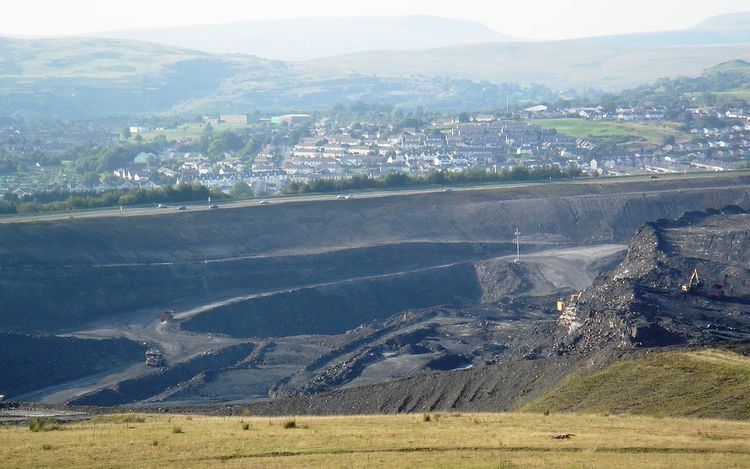 | ||
Address Merthyr Tydfil CF48 4AH, UK | ||
The Ffos-y-fran Land Reclamation Scheme is a major opencast coaling operation to the north-east of Merthyr Tydfil in South Wales. The contracted excavator/reclaiming company is Miller Argent, which is owned by Gwent Investments Limited, a privately-owned family business based in South Wales. The scheme development is the last part of the East Merthyr Reclamation scheme, and will extract 10 million tonnes of coal over 15 years, the revenues from which will redevelop the current former industrial workings into residential and recreational use.
Contents
The opencast coal mine has provoked criticism at a local and national scale, including objections on health and safety grounds as to the close proximity of housing to the site, concerns of the despoiling of the landscape, and global concerns of the contribution of coal to climate change. A number of protests have occurred on and around the site.
Background
Following the 18th century development of Merthyr as an industrial centre, and the shut-down of the deepcast coal mining industry from the 1930s through to the 1980s, the area to the east of Merthyr Tydfil has suffered severe dereliction. The East Merthyr Reclamation Scheme was the initiative of the former Merthyr Tydfil Borough Council and Mid Glamorgan County Council, in partnership with the Welsh Development Agency in the mid 1980s and was launched by the Secretary of State for Wales following the grant of planning permission. The aim was to extract coal from the area of East Merthyr by the cheapest and most profitable means, rather than detracting from it and its environment.
The East Merthyr Reclamation Scheme is a euphemism for opencast mining. The presentation of plans for this include provisions for subsequent reclamation of the landscape. Phases I and II of the Scheme have been completed, restoring 106ha of derelict land to provide residential, light industrial and recreational uses.
The Ffos-y-fran Land Reclamation Scheme is said to be the final stage of the East Merthyr Reclamation Scheme .
Planning
Planning consent for Phase III was granted in November 1988. However, local debates continued over the nature and scale of the development which will lead to the extraction of 10 m tonnes of coal over 15 years; as well as commercial concerns over the size of the coal reserve, together with access rights to the land. Protesters said that if the scheme proceeded, it would mean work taking place just a few hundred metres away from homes in the villages of Dowlais, Mountain Hare, and Penydarren; some houses would be less than 40 m from the boundary of the site.
In 1994 the scheme was revised to claim a larger coal reserve in line with government guidance, termed Phase IIIA. This was withdrawn in May 1999 due to access rights issues.
Access rights were resolved by Miller Argent in 2003, and a new application was brought to Merthyr Council and the Welsh Assembly. In February 2005 the Welsh Assembly approved the Ffos-y-Fran scheme, but the High Court quashed the decision after it was claimed by local residents that Environment Minister Carwyn Jones had made his mind up before the planning committee met.
Mr Jones denied the claim and the Welsh Assembly took the case to appeal judges, who gave final approval of the scheme on 27 November 2006
Scale
The Ffos-y-fran Land Reclamation Scheme is the largest of the original three phases and will restore 367ha of derelict land, including the removal of known shafts previously associated with iron ore and coal workings, to finally complete the original land reclamation scheme.
Statistics surrounding the site which include:
Transport
Under agreed planning rules, the site is not allowed to transport coal from the site via road. All extract is therefore moved to the rear (East) of the site where the coal is separated and washed at the Cwmbargoed Washery. Built in 1959 on land to the north and east of the railway connection to Fochriw Colliery, the coal washery was refurbished by Celtic Energy in 1992. Originally contracted for ten years to trains operated by DB Schenker, since 2016 Freightliner trains then move the washed coal from site to Aberthaw Power Station, along the former route of the Rhymney Railway. Joining the modern Rhymney Line just south of Ystrad Mynach railway station, the trains then travel onwards via Cardiff and the Vale of Glamorgan Line to Aberthaw, enabling Ffos-y-fran to supply 40% of the coal to Aberthaw power station.
